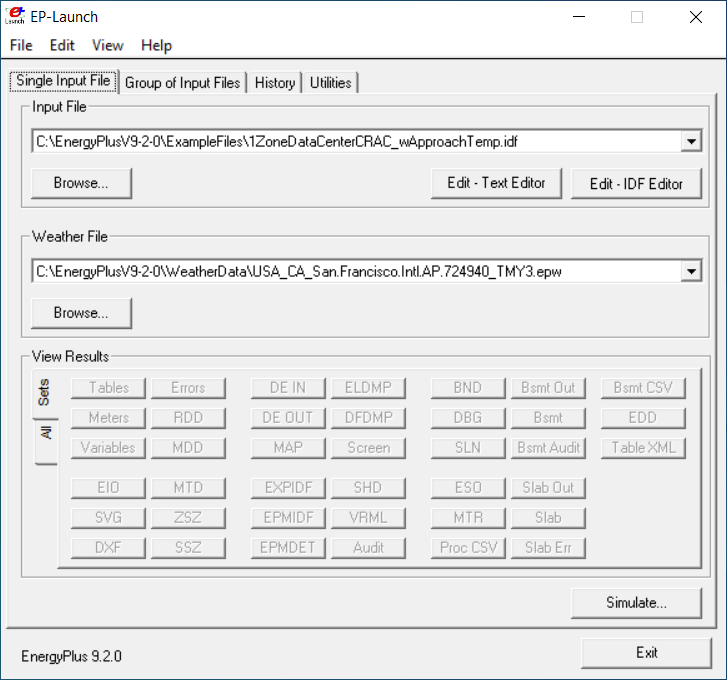- Date added:
- Feb 21, 2022 | Last update check: 1 minute ago
- Integrations:
- —
- Licence:
- Open Source
- Runs on:
- Windows 10 / 10 64-bit
EnergyPlus is a whole building energy simulation program that engineers and architects use to model both energy consumption and water use in buildings. Energy consumption includes heating, cooling, ventilation, lighting and plug and process loads.
Features:
- Integrated, simultaneous solution of thermal zone conditions and HVAC system response that does not assume that the HVAC system can meet zone loads and can simulate un-conditioned and under-conditioned spaces.
- Heat balance-based solution of radiant and convective effects that produce surface temperatures thermal comfort and condensation calculations.
- Sub-hourly, user-definable time steps for interaction between thermal zones and the environment; with automatically varied time steps for interactions between thermal zones and HVAC systems. These allow EnergyPlus to model systems with fast dynamics while also trading off simulation speed for precision.
- Combined heat and mass transfer model that accounts for air movement between zones.
- Advanced fenestration models including controllable window blinds, electrochromic glazings, and layer-by-layer heat balances that calculate solar energy absorbed by window panes.
- Illuminance and glare calculations for reporting visual comfort and driving lighting controls.
- Component-based HVAC that supports both standard and novel system configurations.
- A large number of built-in HVAC and lighting control strategies and an extensible runtime scripting system for user-defined control.
- Functional Mockup Interface import and export for co-simulation with other engines.
- Standard summary and detailed output reports as well as user definable reports with selectable time-resolution from annual to sub-hourly, all with energy source multipliers.
What’s new in version 9.6.0:
- Add option for the weather data interpolations for the first few sub-hour timesteps.
- Add Space Concept to EnergyPlus Zone Structure, Part 1.
- Airflow Network Default Behavior Enhancements.
- Waterside economizer coil new feature CoilSystem:Cooling:Water.
- Add a Specified Flow Element to AirflowNetwork.
- New Feature Runaround Heat Recovery Loop.
For a full list of improvements please visit https://github.com/NREL/EnergyPlus/releases/tag/v9.6.0.
About EP-Launch Program
Like all simulation programs, EnergyPlus consists of more than just an executable file. EnergyPlus needs various input files that describe the building to be modeled and the environment surrounding it. The program produces several output files, which need to be described or further processed in order to make sense of the results of the simulation. Finally, even in stand-alone mode, EnergyPlus is usually not executed “by hand”, but rather by running a procedure file which takes care of finding input files and storing or further processing the output files. To assist those in the Windows environment, developer has included the EP-Launch program.
EP-Launch is an optional component of the EnergyPlus Windows installation (it is not available for Linux and Mac platforms). For users that want a simple way of selecting files and running EnergyPlus, EP-Launch provides this and more. In addition, EP-Launch can help open a text editor for the input and output files, open a spreadsheet for the postprocessor results files, a web browser for the tabular results file, and start up a viewer for the selected drawing file.
EnergyPlus file extensions
Input files
The following files are input to the EnergyPlus program.
- IDD (input data dictionary),
- IDF (input data file),
- IMF (input macro file),
- ini (EnergyPlus initialization file),
- epw (EnergyPlus weather file).
Primary output files
The following output files are the most important for beginning users.
- err (a text file containing the error messages issued by EnergyPlus. This is the first output that should be examined after a simulation),
- csv (comma separated variable),
- htm/html.
- Other output files
- audit (this is an text file which echoes the IDD and IDF files, flagging syntax errors in either file),
- ESO (EnergyPlus Standard Output),
- EnergyPlus Meter Output (MTR),
- mtd (this file contains all the details about meters),
- EIO (EnergyPlus Invariant Output),
- RDD (Report (variable) Data Dictionary),
- MDD (Report (meter) Data Dictionary),
- dxf (this is a file in AutoCadTM DXF format showing all the surfaces defined in the IDF file).
About U.S. Department of Energy (DOE)
US Department of Energy (DOE) is a government administration that regulates energy policy, research and development. Its mission is to ensure America’s security and prosperity by addressing its energy, environmental and nuclear challenges through transformative science and technology solutions.
US Department of Energy was founded in 1977 and is based in Washington, D.C.
